A Winter's Tale: The Matysiks Visit Japan, Part 3--Hiroshima
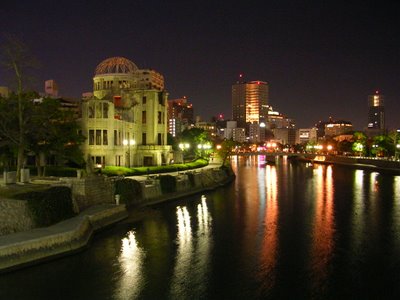 Saturday, December 30th, 2006: After an extremely uncomfortable night on a coach bus (carrying us from Tokyo to the Kansai region), we finally stepped foot into Hiroshima around 8:30am. Overtired and with swollen feet, we hobbled into the cold morning air and tried to determine the way to our hotel. Outside of the bus terminal, we saw a city of modern buildings and streetcars--all the hustle and bustle of a major urban area. And once I saw this,
Saturday, December 30th, 2006: After an extremely uncomfortable night on a coach bus (carrying us from Tokyo to the Kansai region), we finally stepped foot into Hiroshima around 8:30am. Overtired and with swollen feet, we hobbled into the cold morning air and tried to determine the way to our hotel. Outside of the bus terminal, we saw a city of modern buildings and streetcars--all the hustle and bustle of a major urban area. And once I saw this, 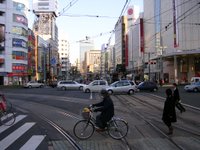 even before we made it anywhere near the Peace Park, I felt emotions welling up inside me, knowing that the morning the bomb was dropped, the city must have looked somewhat similar to this day. So, suppressing the lump in my throat, I followed everyone into an elevator (which took us below the city streets into a passageway leading to the other side of the street). Once there, we crossed traffic and stood, waiting at the streetcar platform. Soon, out of the stream of cars flooding past us, a space-age looking tram approached our terminal. We boarded the car and rode it to Hiroshima-eki. Once there, we disembarked, walked a few blocks, and finally found our little ryokan (Japanese-style) hotel. Collapsing in the small dining area, finally rid of the weight of our heavy bags and coats, we enjoyed some hot tea and snacks (provided by the nice hotel ladies). Having rested for an hour or so, we decided to try to find our way to the Genbaku Dome (Atomic Dome), and so, heading back to the tram stop, we hopped on another street car
even before we made it anywhere near the Peace Park, I felt emotions welling up inside me, knowing that the morning the bomb was dropped, the city must have looked somewhat similar to this day. So, suppressing the lump in my throat, I followed everyone into an elevator (which took us below the city streets into a passageway leading to the other side of the street). Once there, we crossed traffic and stood, waiting at the streetcar platform. Soon, out of the stream of cars flooding past us, a space-age looking tram approached our terminal. We boarded the car and rode it to Hiroshima-eki. Once there, we disembarked, walked a few blocks, and finally found our little ryokan (Japanese-style) hotel. Collapsing in the small dining area, finally rid of the weight of our heavy bags and coats, we enjoyed some hot tea and snacks (provided by the nice hotel ladies). Having rested for an hour or so, we decided to try to find our way to the Genbaku Dome (Atomic Dome), and so, heading back to the tram stop, we hopped on another street car  and were on our way to the Peace Park.
and were on our way to the Peace Park.The dome was in sight as we stepped out of the street car and into the bright winter day. Crossing the road and entering the park, the ominous, frightenly-ghostly shell of a building loomed before us--exposed to the elements, hiding nothing from the eye. We quietly circled the building, our once-smiling faces dropping into serene, contemplative forms. The feelings this building evokes from one gazing upon it are, in reality, indescriba
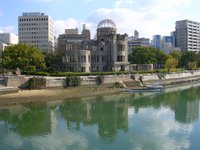 ble. Reading that this building, once a teeming, cultural center, full of life and beauty, was only 500 meters from the epicenter of the bomb and that the people inside were immediately engulfed in fiery flames made my heart drop to my stomach. Yet, I couldn't stop looking--I felt like I had to look, I had to feel nauseous, I had to etch this imagine into my mind forever. Seeing the sun's rays caress the barren structure, while ravens took perch amongst the debris and exposed metal beams, I felt a distinct, fleeting sense of hatred for humankind--for the suffering and atrocities we bring upon one another. At the same time, though, this dome--this phantom building--is truly an ever-lasting reminder of what we cannot repeat again. And while crossing the bridge to walk through the rest of the park, I looked back on the building with a morbid sense of beauty and hope. It is difficult to describe, so I must leave it at that.
ble. Reading that this building, once a teeming, cultural center, full of life and beauty, was only 500 meters from the epicenter of the bomb and that the people inside were immediately engulfed in fiery flames made my heart drop to my stomach. Yet, I couldn't stop looking--I felt like I had to look, I had to feel nauseous, I had to etch this imagine into my mind forever. Seeing the sun's rays caress the barren structure, while ravens took perch amongst the debris and exposed metal beams, I felt a distinct, fleeting sense of hatred for humankind--for the suffering and atrocities we bring upon one another. At the same time, though, this dome--this phantom building--is truly an ever-lasting reminder of what we cannot repeat again. And while crossing the bridge to walk through the rest of the park, I looked back on the building with a morbid sense of beauty and hope. It is difficult to describe, so I must leave it at that.
The rest of the park was tastefully laid out--with memorials scattered throughout th
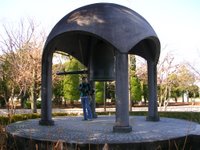 e grounds--and we all were so happy to be walking amongst the many trees and gardens, taking in this place and its history. Once a hip, happening part of Hiroshima, it is now a memorial, forever preserving what happened sixty-t
e grounds--and we all were so happy to be walking amongst the many trees and gardens, taking in this place and its history. Once a hip, happening part of Hiroshima, it is now a memorial, forever preserving what happened sixty-t wo years ago. Where buildings used to stand and people used to shop and eat their meals, there is now a peace bell, an internal flame of peace, a war-museum, a children's monument (where thousands of paper cranes line glass cases, remind us of the after-effects of war on those too small to remember it), and even a monument for all the Koreans who were killed by the blast as well. The museum was, unfortunately, closed on the 30th (for the New Year's holiday) but it didn't really matter. The power of the park and memorials spoke to us in their own way. Pictures were unnecessary to helping us imagine what it must have been like.
wo years ago. Where buildings used to stand and people used to shop and eat their meals, there is now a peace bell, an internal flame of peace, a war-museum, a children's monument (where thousands of paper cranes line glass cases, remind us of the after-effects of war on those too small to remember it), and even a monument for all the Koreans who were killed by the blast as well. The museum was, unfortunately, closed on the 30th (for the New Year's holiday) but it didn't really matter. The power of the park and memorials spoke to us in their own way. Pictures were unnecessary to helping us imagine what it must have been like.
After walking around the park for an hour or so, we decided to cro
 ss the bridge (which had been the target for the bombers) and meander through city, on our way to Hiroshima-jo (a newly-rebuilt castle--the original, of course, was destroyed in 1945). The castle was slightly unimpressive, so, deciding that we needed a break from the cold and walking, we made our way over to another part of the city (first stopping at a bookstore and a shopping center to look around). We found a nice little restaurant with veggie sandwiches--a first for Matt and me in Japan. After a nice, filling "western-style"
ss the bridge (which had been the target for the bombers) and meander through city, on our way to Hiroshima-jo (a newly-rebuilt castle--the original, of course, was destroyed in 1945). The castle was slightly unimpressive, so, deciding that we needed a break from the cold and walking, we made our way over to another part of the city (first stopping at a bookstore and a shopping center to look around). We found a nice little restaurant with veggie sandwiches--a first for Matt and me in Japan. After a nice, filling "western-style" 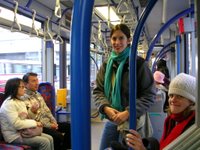 meal, we went back to the hotel, where we showered, rested, drank tea and took it easy for a few hours (I seem to remember that we watched a TV program where these two men were visiting various spas around Japan and enjoying onsens too--but I could be wrong).
meal, we went back to the hotel, where we showered, rested, drank tea and took it easy for a few hours (I seem to remember that we watched a TV program where these two men were visiting various spas around Japan and enjoying onsens too--but I could be wrong).The sky grew dark and the lights of the city began to shine through our hotel windows. We
 bundled back up in our coats, scarves, hats and mittens and headed out into the night. Back at the dome (we wanted to take pictures of it lit up at night), all the feelings we felt earlier in the day returned to us. Against the black sky, the dome glowed like a lantern, both guiding and warning people of a past drenched with fear, anger, sadness and healing. Unlike the park--the hallowed ground--the streets surrounding the calm and stately memorials were alive and healthy and we soon perked up in the presence of so many young, vivacious people. We had a great dinner of Hiroshi
bundled back up in our coats, scarves, hats and mittens and headed out into the night. Back at the dome (we wanted to take pictures of it lit up at night), all the feelings we felt earlier in the day returned to us. Against the black sky, the dome glowed like a lantern, both guiding and warning people of a past drenched with fear, anger, sadness and healing. Unlike the park--the hallowed ground--the streets surrounding the calm and stately memorials were alive and healthy and we soon perked up in the presence of so many young, vivacious people. We had a great dinner of Hiroshi ma okonomiyaki (very different from the kind found in Yamanashi) and then we stumbled upon a Jazz bar. We enjoyed various drinks and good jazz music and had a very relaxing end to our emotional day. Leaving the bar, Allison and I startled a Japanese man with our "gaijin" faces and had a good laugh about it. Tired and cold, we happily found a warm seat on the street car and, entering our hotel room once again, we contently crawled into our respective futons, reflecting on the day and all that it meant to us as Americans.
ma okonomiyaki (very different from the kind found in Yamanashi) and then we stumbled upon a Jazz bar. We enjoyed various drinks and good jazz music and had a very relaxing end to our emotional day. Leaving the bar, Allison and I startled a Japanese man with our "gaijin" faces and had a good laugh about it. Tired and cold, we happily found a warm seat on the street car and, entering our hotel room once again, we contently crawled into our respective futons, reflecting on the day and all that it meant to us as Americans.


0 Comments:
Post a Comment
<< Home